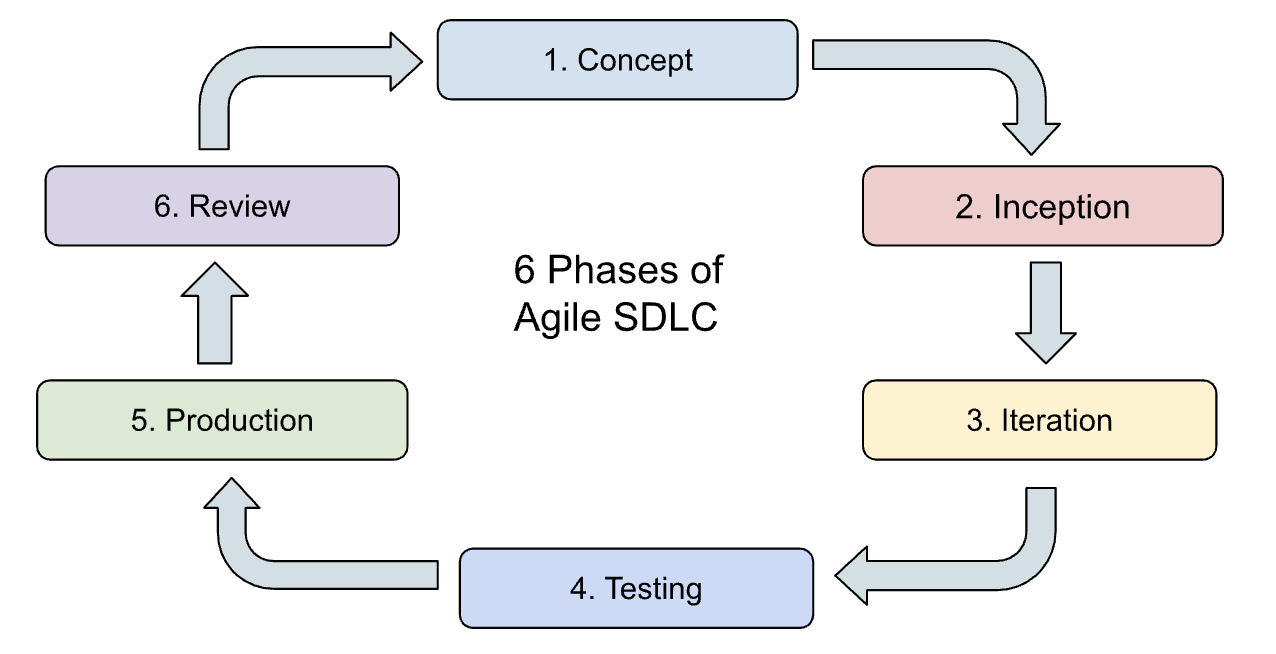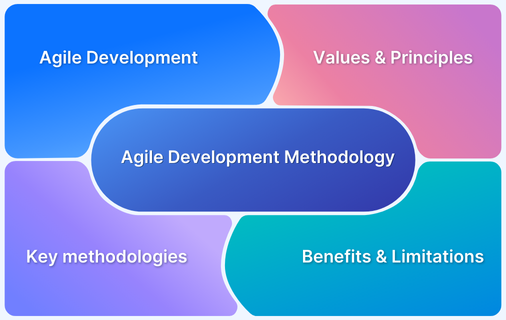Agile software development allows teams to adapt quickly to changes and deliver functional software in shorter cycles.
Overview
What is Agile Software Development Life Cycle (SDLC)?
Agile Software Development Life Cycle (SDLC) is an iterative model that focuses on collaboration, customer feedback, and quick, incremental releases. Unlike traditional software development models like waterfall, Agile does not require detailed upfront planning.
Key Features of Agile Software Development Life Cycle (SDLC)
Here are four key features of Agile SDLC.
- Iterative and incremental: Software is developed in small parts, with each part building on the last to improve the product gradually
- Short cycles: Work is done in fixed periods (usually 1 to 4 weeks), allowing regular progress and quick adjustments
- Continuous feedback: Teams collect input from customers and stakeholders regularly to guide development in the right direction
- Cross-functional teams: Team members from different areas (like design, development, and testing) work closely together throughout the project
Benefits of Agile Software Development Life Cycle (SDLC)
Here’s why to use Agile SDLC.
- Increased flexibility: The team can quickly respond to feedback, unexpected changes, or new requirements without significant delays
- Faster delivery: Useful parts of the software are released regularly, so customers don’t have to wait for the final product
- Improved collaboration: Teams work closely with each other and with stakeholders, which leads to better communication and shared understanding
- Early issue detection: Regular testing and feedback help find and fix problems early, making the process more efficient
This article explains what Agile SDLC is, why it’s important, its different phases, and how to implement Agile methodology.
What is the Agile SDLC Model?
The Agile SDLC (Software Development Life Cycle) model is a flexible approach to software development that prioritizes collaboration, adaptability, and quick iteration. Unlike traditional models that follow a strict sequence, Agile allows teams to adjust their plans and incorporate feedback at any stage, making it ideal for projects where requirements may evolve.
In Agile SDLC, the process is divided into short, manageable cycles called “sprints” or “iterations.” Each sprint includes planning, development, testing, and feedback sessions, ensuring continuous improvement and regular check-ins. This model is all about teamwork, frequent product updates, and delivering value to customers at every step.
4 C’s of Agile
The 4 C’s: Clarity, Commitment, Comment, and Coach are principles that support accountability and performance in Agile teams. Each plays a critical role in maintaining alignment, transparency, and growth within the team.
- Clarity: Clarity ensures everyone knows what’s expected. Define clear goals, roles, and responsibilities at the start of the sprint to minimize confusion and promote accountability.
- Commitment: Commitment involves team members taking ownership of tasks. Have team members commit to specific tasks during sprint planning and daily stand-ups.
- Comment: It involves providing immediate, constructive feedback when goals aren’t met.
- Coach: Coaching involves guiding and mentoring team members to improve their skills. Schedule regular meetings to provide feedback, discuss challenges, and offer advice on skill development.
Must Read: How do Agile and DevOps interrelate?
Why is Agile SDLC important?
Agile SDLC is important because it allows teams to adapt to changing requirements and deliver frequent, high-quality updates. Here are some more reasons why Agile SDLC is important.
- Customer-Centric Approach: Agile prioritizes delivering value to the customer by continuously gathering feedback and aligning the product with customer needs.
- Adaptability to Change: It easily accommodates evolving requirements to ensure the product stays relevant and meets market demands.
- Reduced Project Risks: Agile, combined with DevOps practices like continuous integration and regular testing, helps identify issues early. This leads to better software performance, reliability, and user satisfaction.
Read More: How do Agile and DevOps interrelate?
- Faster Decision-Making: Agile’s short cycles and regular reviews help make quicker, more informed decisions by providing up-to-date information on the project’s progress and challenges.
- Improved Collaboration: Agile model fosters strong collaboration between cross-functional teams, customers, and stakeholders to ensure everyone is aligned and working toward common goals.
- Better Transparency: Agile promotes clear visibility into the project’s progress through regular reviews and enables stakeholders to track key metrics.
Types of Agile SDLC Model
Each Agile model shares core Agile values, though their specific practices and structures vary. Some popular Agile SDLC models are listed below –
- Crystal Agile Methodology: Crystal focuses on effective team communication and adaptability, considering the human aspects essential for successful development. It’s ideal for projects with high uncertainty and frequent requirement changes.
Example: A startup building a new product that may pivot based on early user feedback can benefit from Crystal’s flexible, people-focused approach. - Dynamic Systems Development Method (DSDM): DSDM is designed for projects with moderate to high uncertainty, offering clear roles and governance for quick delivery.
Example: Enterprises working on complex systems, like internal HR platforms, benefit from DSDM’s structured roles and short time frames. - Feature-Driven Development (FDD): FDD focuses on creating a list of features and using iterative feature design and development to meet project goals.
Example: Suitable for large-scale projects with specific, detailed requirements, like e-commerce websites that need frequent updates to meet customer expectations. - Scrum: Scrum is a widely used framework ideal for managing complex projects through iterative sprints. It includes roles such as the Scrum Master, Product Owner, and Development Team to facilitate project success.
Example: Scrum is ideal for software teams building complex applications, such as mobile apps, where continuous feedback and updates are essential. - Extreme Programming (XP): XP emphasizes practices like pair programming, continuous integration, and test-driven development to adapt to frequent changes.
Example: Used in high-uncertainty projects, like financial tech applications, where rapid adaptation to regulatory changes and new user needs is critical. - Lean Development: Lean aims to streamline the process by eliminating waste and optimizing value, inspired by lean manufacturing principles.
Example: Lean is beneficial in SaaS product development, where fast, efficient delivery and constant refinement are key to staying competitive. - Unified Process (UP): UP combines iterative development with elements of both Agile and Waterfall, suited for projects needing a balanced approach.
Example: Unified Process is useful in regulated industries, like healthcare software, where strict requirements exist but incremental progress is also needed.
Different Phases of Agile Development
The Agile SDLC is broken down into six key phases, each designed to drive continuous collaboration, feedback, and improvement throughout the software development process.
1. Concept: In the concept phase, the initial idea for the project is defined, and stakeholders align on goals, target audience, and desired outcomes. The main objective is to understand the problem that needs to be solved and establish the overall vision for the product.
2. Inception: In the inception phase, the team plans and organizes the project. They form the core team, identify the required resources, and define the project scope.
3. Iteration: The iteration phase is where the actual development begins. Work is broken down into small, manageable units known as sprints. Each sprint aims to complete specific features or tasks, and progress is regularly reviewed to ensure alignment with the project goals and customer needs.
4. Testing: In the testing phase, the developed features undergo rigorous testing to ensure they meet quality standards and function as intended. This helps identify and address software bugs.
5. Production: Once the product is tested, it moves into production. The final version is released and made available to customers or users.
6. Review/Maintenance: After releasing the product, the team monitors its performance to identify any issues or areas for improvement. They collect user feedback and use it to make necessary adjustments or updates.
How to Implement an Agile SDLC
Follow these steps to implement an Agile Software Development Lifecycle (SDLC).
1. Select the Right Agile Framework
Agile model offers different frameworks, including Scrum, Kanban, and Lean. Assess your project’s needs to choose the most suitable framework.
- Scrum is ideal for projects with fixed goals that require frequent iterations and regular feedback loops.
- Kanban suits projects requiring flexible priorities and continuous delivery without fixed iterations.
- Lean focuses on eliminating waste and improving efficiency in the process.
2. Establish Core Roles and Responsibilities
Agile methodology depends on well-defined roles, including Product Owner, Scrum Master (for Scrum), and development team members. Clear role definitions ensure accountability and smooth execution throughout the lifecycle.
- The Product Owner manages the product backlog, ensures prioritization based on value, and communicates with stakeholders.
- The Scrum Master facilitates Agile ceremonies, removes obstacles, and ensures adherence to Agile principles.
- Development teams create product increments and release them at the end of each sprint.
3. Build the Product Backlog
The Product Backlog is a prioritized list of features, tasks, and fixes.
- Collaborate with stakeholders to define product features based on business needs, customer demands, and technical feasibility.
- Each item in the backlog should have clear descriptions, business value, and estimated effort.
- Continuously refine and prioritize the backlog during sprint planning and backlog grooming sessions to ensure the most valuable features are built first.
4. Plan and Conduct Sprints
Agile methodology works in short, time-boxed intervals called sprints (typically 1-4 weeks).
- Hold a sprint planning meeting to define specific goals and deliverables at the start of each sprint.
- Break down tasks into smaller, manageable units and assign them to the team members.
- Track the progress of each sprint using tools like burn-down charts or Kanban boards to monitor work completion.
5. Integrate Continuous Testing and Feedback
Testing should be integrated into every sprint, not just at the end of the project.
- Ensure test-driven development (TDD) practices are in place, where tests are written before the code.
- Use automation testing tools to streamline the testing process and ensure faster feedback.
- Collect feedback from stakeholders regularly, especially after each sprint, and use the input to adjust priorities.
6. Measure Performance with KPIs
Define key performance indicators (KPIs) that align with your project’s specific goals. These metrics help track progress, evaluate outcomes, and guide data-driven decisions throughout the project lifecycle.
- Track metrics like velocity (the amount of work completed in each sprint), lead time (time taken from request to delivery), and cycle time (time from task start to completion).
- Regularly analyze these KPIs to measure team performance, predict future capacity, and adjust processes where necessary.
7. Hold Regular Meetings
Regular meetings are essential to keeping the team aligned, tracking progress, and ensuring continuous improvement. Hold daily stand-ups to address progress and obstacles, sprint reviews to gather feedback from stakeholders, and sprint retrospectives to reflect on performance and identify areas for improvement.
8. Ensure Continuous Delivery
Continuous Delivery is a software development practice in which code changes are automatically built, tested, and prepared for deployment to production. By delivering incremental updates, continuous delivery reduces the risk of large failures and ensures faster value delivery to customers. Here’s how to enable continuous delivery.
- Automate the deployment pipeline to streamline build, test, and release processes.
- Integrate code frequently to detect and resolve issues early.
- Deliver small, incremental features that are ready for release after each sprint.
- Use automation testing to ensure stability and functionality before deployment.
- Keep the main branch production-ready to allow fast and safe releases anytime.
9. Adapt and Evolve the Process
Agile cycle is iterative, meaning the process itself should evolve.
- Review performance regularly and adjust your processes based on data and team feedback.
- Use sprint retrospectives to identify bottlenecks, inefficiencies, or communication gaps and make changes accordingly.
Agile vs Traditional SDLC Models
The comparison between Agile and traditional SDLC models highlights the differences in approach, flexibility, and responsiveness to change. While traditional methods like Waterfall follow a linear, structured path, Agile promotes flexibility, collaboration, and iterative development.
| Parameter | Agile SDLC | Traditional SDLC |
|---|---|---|
| Approach | Iterative and flexible, allowing for frequent updates | Linear and sequential, with each phase completed before moving to the next |
| Customer Involvement | Continuous feedback and collaboration throughout the process | Limited involvement, usually at the start and end |
| Flexibility | Highly adaptable to changing requirements | Difficult to change once development begins |
| Documentation | Focuses on delivering working software, with minimal documentation | Extensive documentation at each phase before moving forward |
| Delivery | Frequent releases in short cycles (sprints) | Single release at the end of the project |
| Risk Management | Ongoing risk assessment with frequent adjustments | Risk is identified upfront but not revisited until later phases |
| Team Collaboration | Cross-functional teams with regular communication | Team roles are more siloed with less frequent interaction |
Read More: Agile vs. Waterfall: Key Differences
Scrum vs Agile SDLC: Comparison
Scrum in Agile is a method that enables software development teams to focus on delivering business value in the shortest time possible by inspecting functioning software repeatedly and rapidly. Scrum Framework typically addresses the fact that requirements are susceptible to change or are typically unknown at the outset of a project.
| Agile | Scrum |
|---|---|
| Agile is a continuous iteration of software development and testing, | Scrum is an Agile process that focuses on delivering business value in the minimum time possible. |
| Agile methodology regularly delivers software for feedback | Scrum delivers software after each iteration. |
| In the Agile methodology, leadership is crucial | Scrum fosters a self-organizing, cross-functional team. |
| Agile entails collaborations and face-to-face interactions between members of multiple cross-functional teams, | Scrum collaboration is accomplished through daily stand-up meetings. |
| Agile process design and execution should be kept straightforward | Scrum process design and execution can be innovative and exploratory. |
Limitations of Agile SDLC
Despite its potential benefits, Agile is not for everyone. Therefore, it is essential to understand the disadvantages of Agile methodology. In light of this, the following are five major disadvantages of Agile.
- Poor resource allocation: Because Agile is predicated on the notion that teams won’t know what their end result (or even a few cycles of delivery down the road) will look like from day one, it’s difficult to predict cost, time, and resources at the outset of a project (and this difficulty increases as projects become larger and more complex).
- Limited documentation: In Agile, documentation occurs throughout a project and frequently “just in time” for constructing the output, as opposed to at the outset. Consequently, it becomes less specific and is frequently pushed to the back burner.
- Dispersed output: Incremental delivery may aid in bringing products to market more quickly, but it is a major drawback of Agile methodology. When teams focus on each component in separate cycles, the final product is frequently fragmented, as opposed to a unified whole.
- No finite conclusion: Due to the fact that Agile requires minimal planning at the outset, it is simple to deliver new, unanticipated functionality. In addition, it implies that initiatives have no definitive conclusion because the “final product” is never clearly defined.
- Difficult measurement: Because Agile delivers in increments, tracking progress necessitates a cross-cycle perspective. And because of the “see-as-you-go” nature, you cannot establish many KPIs at the outset of the project. This lengthy game makes it difficult to measure progress.
Read More: Debunking Myths about Agile Testing
Why Implement Agile SDLC with BrowserStack
BrowserStack is a cloud-based testing platform that helps Agile teams deliver high-quality applications through fast, reliable, and scalable testing. It supports Agile SDLC by enabling continuous testing across real browsers and devices and integrating with CI/CD pipelines to catch issues early and speed up delivery.
The key features of BrowserStack include,
- Seamless CI/CD Integration: Run automated tests on every code commit using tools like Jenkins or GitHub Actions to support fast, reliable delivery.
- Real Device Cloud: Validate app performance on 3,500+ real mobile devices and browsers to catch device-specific issues early.
- Parallel Testing: Runs hundreds of tests at once to accelerate feedback during sprints and reduce testing time.
- Shift-Left Testing: Supports early-stage testing by allowing teams to test features during development rather than after completion
- Comprehensive Debugging: Access the console, logs, and screenshots to debug issues and easily log them in Jira, Trello, GitHub, or Slack.
Conclusion
The Agile SDLC model helps teams build software through short cycles, regular feedback, and continuous improvement. It replaces rigid planning with adaptable workflows to manage change and reduce risk.
Integrating BrowserStack into your Agile SDLC enhances testing by providing real device access and cross-browser compatibility. You can run automated tests on a wide range of real mobile and desktop devices, execute parallel tests, and integrate seamlessly with CI/CD pipelines for continuous and efficient testing.
Frequently Asked Questions
1. How long should an Agile sprint last?
An Agile sprint usually lasts between 1 and 4 weeks, with 2 weeks being the most common duration. The ideal sprint length depends on the team’s pace and the complexity of the work.








